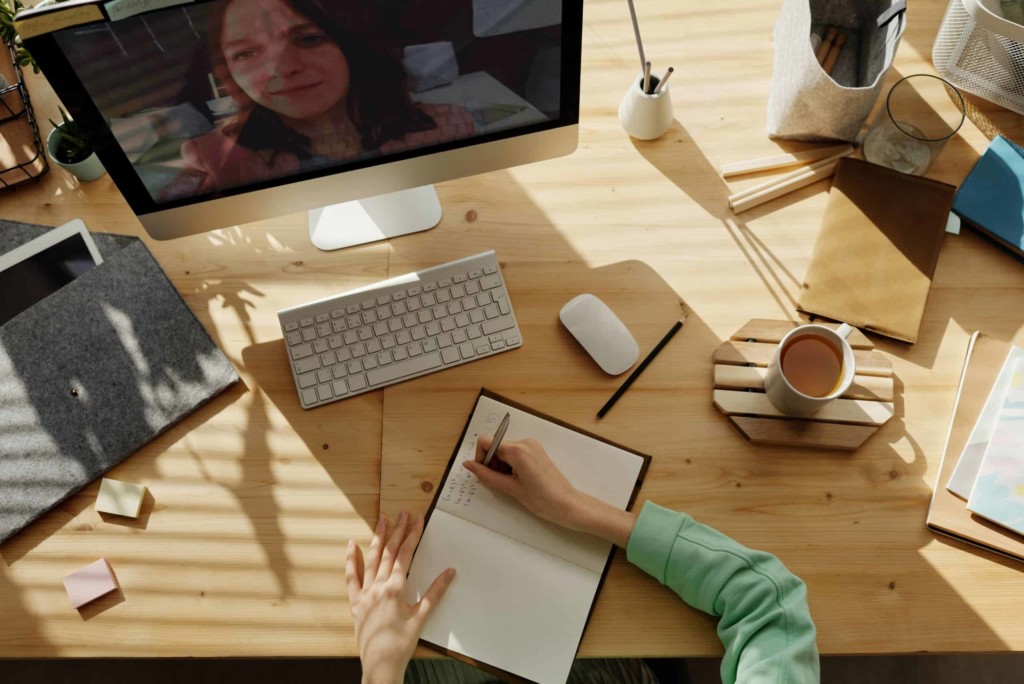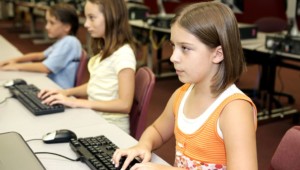Reflecting on the Hybrid Experience

Having taught the first nine weeks of the school year fully virtual, it took some time to adjust to all that goes into teaching online. Unlike the end of the past school year, we were running a regular schedule with classes meeting synchronously. After the first two days, I quickly figured out that I needed more than one computer and headphones. I needed at least two devices, a computer stand or two, and a ring light so that my students could actually see me. Beyond these tech adjustments, there was a struggle to get into a workflow. While we do many of the same tasks in our physical classroom space, it takes less time and the way we complete them looks different.
It was a process. Remembering to take attendance, mute and unmute myself, record the lesson, and make sure I turned off the incoming video for the students first, took some time. Developing a routine so I could minimize loss of instructional time as I worked to share my screen and verify it could be seen, teach while also letting students in who kept getting kicked out of meetings or were coming late to class, and remember to download the attendance list before ending the meeting. Of course, that meant I had to end the meeting, rather than just leave, otherwise the meeting continues and I don’t get the recording. Remember to download and then upload the recording to each class Teams space. This is just a short list of the tasks that we have to keep up with when teaching in the virtual space and if all students are learning remotely.
To say that it’s exhausting is an understatement. There are a lot of things to balance, challenges we have to push through, and roadblocks that pop up, especially when it comes to technology. We need to make sure our students can participate and that we provide them with the most meaningful learning experience that we can while also acknowledging that we are not in a typical learning situation.
While it was challenging, part of me wanted to stay with virtual learning because I felt like I finally had a good workflow and had improved on the types of learning opportunities I was creating for my students. But I also wanted to shift to hybrid so I had that time in class to see the students. Neither of these is ideal and I look forward to when we can all be back in our classrooms together.
Preparing for the shift
How do you teach in this type of hybrid, the teaching live and online simultaneously? I tried to prepare myself ahead of time by joining in discussions in different learning communities, participating in Twitter chats, and asking my own questions to find out what other teachers were experiencing. What many of them said was that it was overwhelming doing two jobs at the same time. Beyond its impact on us as teachers, I worry about the students who have questions that most likely can’t ask them because teachers are interacting with the students in the physical classroom or vice versa. It is a lot to take on and it’s not ideal but what I learned from spring school closures is that you have to make the best of it and you do the best you can.
How do you prepare? You have to be intentional about the types of learning experiences our students need. They need to feel comfortable in their learning space wherever that is. They need to be able to ask questions and find resources whenever they need them. We need support from our administrators when it does become overwhelming or we’re exhausted because we are and will continue to be. We need to know that it’s okay to take a break and to not have to worry so much about covering all of the same content that we normally would in any other “normal” school year. Nothing about this right now is normal and unfortunately, the likelihood is that it won’t return to normal anytime soon.
From the spring until now I’ve changed a lot about myself as a teacher. It has been hard to break away from the typical activities, content, or other materials that I have been accustomed to using in my classroom. But what I have learned is that we really need to think about how to best assess students and give them opportunities to practice because the answers are all over the Internet. As a language teacher, I battle against the use of online translators and a website that provides students with answers to any textbook or workbook you can find. There is also the issue of students copying each other’s homework. With these challenges, it forces us to think very carefully about what we’re asking our students to do. I tried some new tools thinking I could steer students away from using those and it was an improvement but there were still problems.
When it comes to technology, we can’t assume that students know exactly how to use it so we have to show them. When they use the technology for copying text directly from a website or in my class, using a translator, or finding an answer key, it is so frustrating. It is a struggle but we need to instead teach them why they shouldn’t use these tactics and how it negatively impacts their learning potential.
The great balancing act
The first day was interesting making the adjustments to our new classroom procedures and setup. As students come in, they grab towels to wipe down their desks and then log into the Teams meeting on their phone so they can access any notes in the chat. I have a workspace at the front of the room, with one computer on a stand in front of me and my other computer propped up so that if I am screen sharing something on one, I can let students into the Teams meeting on the other computer. I use the stand so I am visible to the students in my classroom and online however I felt like I was greatly limiting my ability to interact with all students.
I started to lose my voice from having to speak louder through the mask and students at home could not hear me well. If the students at home spoke, only I could hear them and if students in the class asked a question, I often could not hear them because of the headset, so I kept having to remove one of the earbuds. I had to keep repeating everything and typing it into the meeting chat so that all students could read the message. When I wrote on the board, students at home could not see what I wrote and so I needed a better plan.
What worries me
There are so many questions and concerns I have, beyond teaching the lesson itself. If I want to give students a paper so we can break from the screen time, I worry about passing out papers or collecting them from students. I worry about them having to sharpen their pencil. I worry that a student did not clean their desk or the desk shield enough. I worry about it all.
When I’m looking in my classroom with my students, I worry that I’m losing the engagement of the students who are at home. That I’m doing them a disservice because I’m somehow not providing enough and that there’s something that I could do better. I asked myself: Should I create a video of myself teaching every single lesson and then have all of the students watch it? Should I have the students at home watch the video while I teach the students in my classroom? When I give a test, do I provide students in the classroom with a paper copy and create a digital assessment for the online students? Should I wait to give all students the test when they’re physically in the classroom so I can answer their questions and make sure they’re not looking up the answer somewhere? But what about the students who are fully virtual? There are so many things to consider each day.
I believe that if schools were doing the four days synchronously and one day asynchronously, then all students would be getting the same instruction, the same activities, they could hear and see the teacher at the same time. In the hybrid world, as it is in this definition of hybrid, I feel like because of the split, we are going to lose more of the students. If we would have them together four out of five days in virtual, I do truly believe that the hybrid cuts that in half. That might be an unpopular opinion but that is what I notice based on my own experience, my thought process, the conversations that I’ve had, and everything that I’ve seen shared from teachers over the last couple of months. It is how I am feeling during my own experience and I’m working on finding ways to improve.
My best tips
What has helped me with some of those initial challenges is bringing in some extra equipment and deciding on a few digital tools to use consistently. First, by using my HUE HD Pro Document camera, students could see me in the classroom and I didn’t have to stay in front of my netbook computer webcam. It also helps with being able to write on paper and share it on the screen for all students to see. Connecting a microphone to my desktop so that the sound could be heard in the classroom, students can speak to each other and I was not attached to my computer, and could move around the room. Making sure that I set everything up ahead of time, keeping a list nearby that reminded me of the time for each class, and a checklist for each period of what we need to do to maintain our safety.
Choose some different digital tools to provide interactive lessons. The tools that I’ve been using the most have been Buncee, Edpuzzle, Formative, Nearpod, Gimkit, and Synth. These are tools we have used for several years however they provide more possibilities for collaboration and are great for having students engage more in the lesson.
The first couple of days of hybrid I felt like I was not managing everything very well. Shifting from fully virtual to hybrid is a big transition for students and teachers and families of course. But when we started virtual, it took a few weeks to feel like I was in a better workflow, and then making the shift to hybrid I felt like I was starting all over again. Although this has been a challenging time with all of our transitions since March, we are much better prepared than we were then. Even if we do have to continue shifting between virtual, hybrid, and in-person, we have more experience and versatile tools available to us and our students that can help and we are building our skill set in the process.
There is no perfect solution but the best that we can do is to keep trying and being open to new ideas and tools and strategies. We need to embrace the challenges and times where we feel like we failed, and learn from it and move on.
For more, see:
- Strategies for Fostering a Productive Distance Learning Experience
- Remote Learning: Lessons Learned and Reflections to Inform the Future
- Making the Most of Distance Learning
Stay in-the-know with innovations in learning by signing up for the weekly Smart Update.








0 Comments
Leave a Comment
Your email address will not be published. All fields are required.